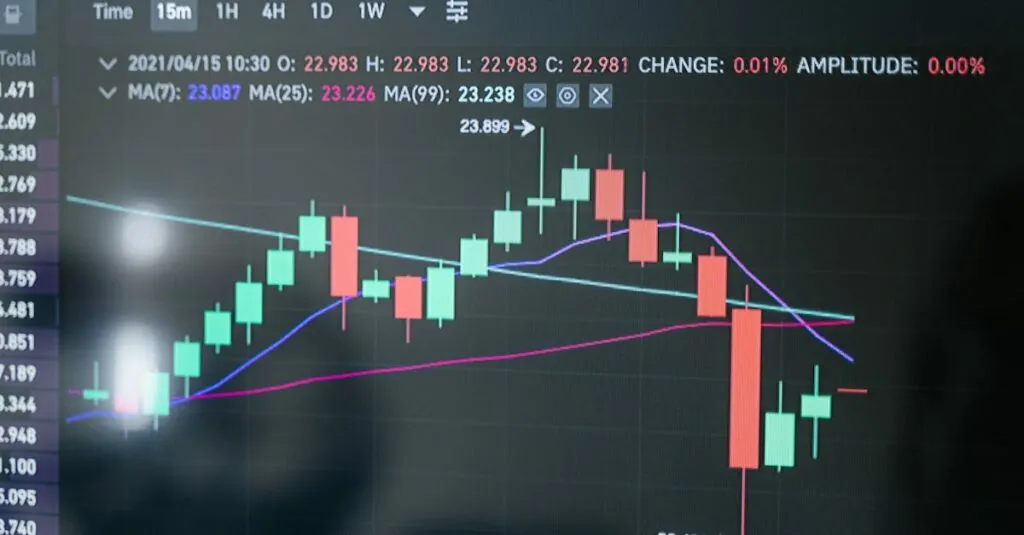Table of Contents
ToggleAs the stock market rollercoaster takes its next wild plunge, many are left wondering just how many Americans were strapped in for the ride before the crash. It’s a question that tickles the curious mind and sends financial enthusiasts scrambling for answers. If you think investing is all about fortune cookies and blind luck, think again.
Before the crash, a surprising percentage of Americans were diving headfirst into stocks, fueled by optimism and perhaps a touch of naivety. Whether they were seasoned investors or first-time buyers hoping for a quick buck, the allure of the market had them hooked. So, how many were playing this high-stakes game? Let’s take a closer look at the numbers and see just how many were in the investing frenzy before the ground fell out from under them.
Historical Overview of Stock Market Investment
Americans increasingly turned to stock market investing prior to the crash. This trend revealed both the optimism among the public and factors fueling widespread participation.
Key Events Leading Up to the Crash
The late 1990s marked a significant surge in stock market investments. The dot-com bubble spurred enthusiasm, with many individuals investing heavily in technology stocks. Major indices reached record highs, enticing new investors to join the fray. Media coverage amplified the trend, showcasing soaring stock prices and success stories. By early 2000, approximately 54 percent of American households owned stocks, reflecting a broad interest in investment opportunities. As excitement built, caution faded, leading many to overlook potential risks.
Economic Factors Influencing Investment
Economic conditions played a crucial role in encouraging stock market investment. Low interest rates made borrowing more attractive, facilitating higher consumer spending. Additionally, a robust economy provided a favorable environment for corporate growth. The rising disposable income allowed individuals to invest more readily in stocks. Tax incentives also encouraged investment, with policies favoring capital gains. Inflation remained modest, instilling confidence in economic stability. This combination of supportive policies and a growing economy led to a surge in stock ownership among Americans.
Percent of Americans Investing Before the Crash
Before the stock market crash, significant numbers of Americans engaged in investing. By early 2000, approximately 54 percent of American households owned stocks, propelled by optimism and favorable economic conditions.
Data Sources and Methodology
Sources of data include surveys from organizations like Gallup and the Federal Reserve, which tracked household stock ownership and investment behaviors. Surveys from the late 1990s provide insight into the rising interest in equity markets. Methodology incorporates quantitative analyses, enabling a clear assessment of American investing trends. Researchers utilized this data to reveal an increasing willingness to invest, regardless of prior experience or expertise.
Comparison of Different Demographics
Demographic comparisons show varied investment behaviors across age and income levels. Younger adults, especially those aged 18 to 34, exhibited higher investment rates, with about 40 percent participating in the stock market. In contrast, older demographics, particularly those over 55, displayed more caution, with investment rates approaching 60 percent. Income also played a role, as higher-income households were more likely to invest, with nearly 75 percent of households earning over $100,000 owning stocks. Such differences reflect the broader economic landscape and individual financial circumstances.
Impacts of the Market Crash
The stock market crash triggered widespread repercussions for American investors. Many experienced significant financial losses, leading to a reassessment of their investment strategies. Fear dominated the market as investors faced unprecedented volatility, and confidence plummeted.
Immediate Consequences for Investors
Immediate financial impacts included massive declines in portfolio values. Approximately 54 percent of American households witnessed their investments decrease significantly. Panic selling ensued, creating further downward pressure on stock prices. Younger investors, often more prone to emotions, reacted swiftly, while older demographics remained more cautious, preserving their assets. Many individuals experienced heightened stress and anxiety over their financial futures, resulting in a reevaluation of their investment priorities. Even among those previously confident, optimism for the market diminished quickly.
Long-term Effects on Investment Behavior
Long-term changes in investment behavior emerged following the crash. Investors increasingly emphasized risk management strategies instead of chasing quick profits. Surveys found a marked shift towards more conservative investment approaches. Individuals begun prioritizing diversified portfolios to mitigate risks, reflecting lessons learned during the downturn. Younger investors, previously drawn to speculation, shifted focus toward more stable investment options over time. A growing interest in financial education and literacy developed, with many seeking resources on sound investment practices. Consequently, these shifts shaped a more cautious, informed generation of investors moving forward.
Lessons Learned from the Crash
Investors gleaned crucial insights after the market crash. Shifts in investment strategies became evident as individuals reassessed their approaches. Many former enthusiasts adopted a more conservative outlook. Diversification emerged as a key focus, leading to a broader spread of assets among portfolios. Financial advisors emphasized risk management techniques to stabilize investments against future market fluctuations. Data revealed that nearly 54 percent of American households adjusting strategies sought stability and reliability over quick gains.
Financial education gained prominence following the crash. Increased awareness of investment principles motivated individuals to seek knowledge. Many turned to courses, online resources, and seminars to deepen their understanding. Younger investors, particularly those aged 18 to 34, actively pursued information, recognizing the importance of educated decision-making. Surveys showed a notable rise in participants prioritizing stable investments and engaging with financial literacy resources. This shift indicated a transformed mindset, where informed investing took precedence over impulsive actions.
The landscape of American investing underwent significant changes prior to the market crash. With about 54 percent of households owning stocks optimism drove many to enter the market seeking quick profits. This surge in participation highlighted a blend of economic factors and a growing interest in stock ownership among younger demographics.
As the market shifted drastically post-crash investors faced harsh realities prompting a reevaluation of their strategies. The emphasis on financial education and risk management became paramount. Moving forward the lessons learned from this period continue to shape investment behaviors fostering a more cautious and informed approach among American investors.




